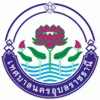Ubon Ratchathani (Ubon Ratchathani)
 |
As of 2006, the Ubon Ratchathani urban area had a population of about 200,000. This included 85,000 in Thetsaban Nakhon Ubon Ratchathani (Ubon municipality), 30,000 each in Thetsaban Mueang Warin Chamrap (Warin municipality) and Thetsaban Tambon Kham Yai, 24,000 in Thetsaban Tambon Saen Suk, 10,000 each in Thetsaban Tambon Pathum and Tambon Kham Nam Saep, and 6,000 in Thetsaban Tambon Ubon.
The city was founded in the late 18th century by Thao Kham Phong, descendant of Phra Wo and Phra Ta, who escaped from King Siribunsan of Vientiane into the Siam Kingdom during the reign of King Taksin the Great. Later, Thao Kham Phong was appointed to be "Phra Pathum Wongsa" (Thai: พระประทุมวงศา) and the first ruler of Ubon Ratchathani. In 1792, Ubon Ratchathani became a province and was also the administrative center of the monthon Isan. Until 1972, Ubon Ratchathani was the largest province of Thailand by area. Yasothon Province was split off from Ubon Ratchathani Province in 1972, followed by Amnat Charoen Province in 1993. Ubon Ratchathani Province now ranks fifth in area.
The city was attacked by French forces during the 1940 Franco-Thai War.
Ubon grew extensively during World War II when Japanese forces brought in prisoners of war by rail from Kanchanaburi, the survivors of the Burma Railway. One legacy of this is a monument in the city's central Thung Si Meuang Park, erected by British prisoners of war in gratitude to the citizens of Ubon Ratchathani for assisting them. During the Vietnam War, United States armed forces constructed Ubon Royal Thai Air Force Base, which is now also a dual-use commercial airport.
Some of the city's religious buildings show the influence of Lao architecture.
The city has branches of the National Archives of Thailand and National Museum of Thailand.
The world-famous meditation teacher Ajahn Chah, teacher of Ajahn Sumedho, was born in Ubon Ratchathani.
Map - Ubon Ratchathani (Ubon Ratchathani)
Map
Country - Thailand
 |
 |
| Flag of Thailand | |
Tai peoples migrated from southwestern China to mainland Southeast Asia from the 11th century. Indianised kingdoms such as the Mon, Khmer Empire and Malay states ruled the region, competing with Thai states such as the Kingdoms of Ngoenyang, Sukhothai, Lan Na and Ayutthaya, which also rivalled each other. European contact began in 1511 with a Portuguese diplomatic mission to Ayutthaya, which became a regional power by the end of the 15th century. Ayutthaya reached its peak during the 18th century, until it was destroyed in the Burmese–Siamese War. Taksin quickly reunified the fragmented territory and established the short-lived Thonburi Kingdom. He was succeeded in 1782 by Buddha Yodfa Chulaloke, the first monarch of the current Chakri dynasty. Throughout the era of Western imperialism in Asia, Siam remained the only nation in the region to avoid colonization by foreign powers, although it was often forced to make territorial, trade and legal concessions in unequal treaties. The Siamese system of government was centralised and transformed into a modern unitary absolute monarchy in the reign of Chulalongkorn. In World War I, Siam sided with the Allies, a political decision made in order to amend the unequal treaties. Following a bloodless revolution in 1932, it became a constitutional monarchy and changed its official name to Thailand, becoming an ally of Japan in World War II. In the late 1950s, a military coup under Field Marshal Sarit Thanarat revived the monarchy's historically influential role in politics. Thailand became a major ally of the United States, and played an anti-communist role in the region as a member of the failed SEATO, but from 1975 sought to improve relations with Communist China and Thailand's neighbours.
Currency / Language
| ISO | Currency | Symbol | Significant figures |
|---|---|---|---|
| THB | Thai baht | ฿ | 2 |
| ISO | Language |
|---|---|
| EN | English language |
| TH | Thai language |















